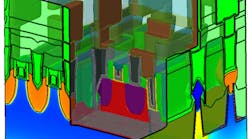This file type includes high resolution graphics and schematics when applicable.
Use of three-dimensional (3D) semiconductor structures has become commonplace within many markets, and in turn, semiconductor-process technologies continue to advance in support of higher-speed, more-dense active devices. For example, Coventor stays at the forefront with new and updated tools that predict the performance of different 3D semiconductor designs.
Case in point is the company’s fifth generation of its process simulation software, SEMulator3D 5.0. The software not only adds features for new process capabilities, but also simplifies the learning process for using the software. It’s a powerful simulation platform for predicting the effects of different process parameters on semiconductor and microelectomechanical-systems (MEMS) devices.
Processes for analog, digital, and optical functionality all can be modeled with SEMulator 3D, including silicon CMOS processes with features as fine as 7 nm. It’s been used by device designers to predict the effects of different process parameters on the performance of 3D memory structures, computer hard-disk read-heads, optical sensors, and high-frequency MEMS switches.
The software is especially useful when evaluating a new semiconductor process or manufacturing equipment or new design approaches, using what the firm refers to as “virtual fabrication” of advanced manufacturing processes. In other words, different variables and conditions can be understood before actually undergoing manufacturing-process time and costs to fabricate a prototype circuit or device.
The SEMulator3D program includes a flexible layout editor to speed and simplify the design process. It also connects to the Cadence Virtuoso software from Cadence Design Systems for design and simulation of advanced integrated circuits (ICs). SEMulator3D can also directly import design details in the form of GDSII layout data. The 3D process simulator and its virtual process capabilities will automatically generate virtual process masks. As a result, designers are able to experiment with the effects of adjustments to the shapes of those semiconductor masks without having to endure the time and expense of a semiconductor-process cycle.
Version 5.0 of this powerful software tool features a new graphical user interface (GUI) for the software’s process editor, designed to simplify how to use the software and speed the process of learning how to use its many features and capabilities. This version of the software also increases the number of supported interfaces. For example, a wide range of parameter-extraction tools helps speed the analysis and development of different semiconductor device/process models.
This latest version of SEMulator3D also boasts enhanced capabilities—process improvements for modeling semiconductor dopants include new process models for ion implantation, thermal diffusion, and in situ doped deposition and epitaxy. An update to the SEMulator3D Viewer provides visualization of different dopant concentrations, showing operators how these different dopant parameters can affect the performance of a different semiconductor structure (see the figure).
Along with usability improvements to the software come functional advances: Enhanced modeling performance gets a boost in speed to deliver more accurate simulation results quicker than previous versions of SEMulator3D. In addition, the Expeditor batch execution engine employed in SEMulator3D was expanded to become the dominant methodology for modeling design and process variations in 3D semiconductor-process technologies. This powerful engine greatly increases the efficiency of automated design-of-experiment (DOE) processes, which explore how changes in process parameters will impact final device operating performance.
This file type includes high resolution graphics and schematics when applicable.
SEMulator3D 5.0 makes it possible to create accurate physics-based process models. It’s invaluable for accelerating the development of advanced semiconductor structures and MEMS devices for a wide range of markets, including automotive, commercial, industrial, and military. The straightforward visualization of process parameters helps find problems quickly, and the simple GUI enables many different groups across a company to achieve consistent results with the software. Perhaps SEMulator3D 5.0 can best be summed up in one tried-and-true axiom: “Seeing is believing.”
Coventor Inc., 1000 Centregreen Way, Suite 200, Cary, NC 27513; (919) 854-7500, E-mail: [email protected]


